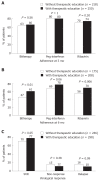Patient education improves adherence to peg-interferon and ribavirin in chronic genotype 2 or 3 hepatitis C virus infection: a prospective, real-life, observational study
- PMID: 18985810
- PMCID: PMC2761581
- DOI: 10.3748/wjg.14.6195
Patient education improves adherence to peg-interferon and ribavirin in chronic genotype 2 or 3 hepatitis C virus infection: a prospective, real-life, observational study
Abstract
Aim: To evaluate the impact of therapeutic education on adherence to antiviral treatment and sustained virological response (SVR) in a real-life setting in genotype 2/3 hepatitis C, as there are few adherence data in genotype 2/3 infection, even from randomized trials.
Methods: This prospective survey included genotype 2/3 patients who received peg-interferon alfa-2b and ribavirin. There was no intervention. Adherence was self-reported over the past 4 wk (peg-interferon) or 7 d (ribavirin). Adherence to bitherapy was defined as adherence to the two drugs for >or= 20 wk. SVR was defined as undetectable RNA >or= 12 wk after the end of treatment.
Results: 370/674 patients received education during the first 3 mo of treatment. After 6 mo, adherence to bitherapy was higher in educated patients (61% vs 47%, P = 0.01). Adherence to peg-interferon was 78% vs 69% (P = 0.06). Adherence to ribavirin was 70% vs 56% (P = 0.006). The SVR (77% vs 70%, P = 0.05) and relapse (10% vs 16%, P = 0.09) rates tended to be improved. After adjustment for baseline differences, education improved adherence [Odds ratio (OR) 1.58, P = 0.04] but not the SVR (OR 1.54, P = 0.06).
Conclusion: In genotype 2/3 patients, therapeutic education helped maintain real-life adherence to bitherapy.
Figures



Similar articles
-
Pegylated interferon plus ribavirin for genotype Ib chronic hepatitis C in Japan.World J Gastroenterol. 2008 Dec 21;14(47):7225-4230. doi: 10.3748/wjg.14.7225. World J Gastroenterol. 2008. PMID: 19084938 Free PMC article. Clinical Trial.
-
Enhanced efficacy of pegylated interferon alpha-2a over pegylated interferon and ribavirin in chronic hepatitis C genotype 4A randomized trial and quality of life analysis.Liver Int. 2011 Mar;31(3):401-11. doi: 10.1111/j.1478-3231.2010.02435.x. Epub 2011 Jan 11. Liver Int. 2011. PMID: 21281434 Clinical Trial.
-
Induction pegylated interferon alfa-2b in combination with ribavirin in patients with genotypes 1 and 4 chronic hepatitis C: a prospective, randomized, multicenter, open-label study.Clin Gastroenterol Hepatol. 2010 Jan;8(1):66-71.e1. doi: 10.1016/j.cgh.2009.08.036. Epub 2009 Sep 10. Clin Gastroenterol Hepatol. 2010. PMID: 19747986 Clinical Trial.
-
Phase III results of Boceprevir in treatment naïve patients with chronic hepatitis C genotype 1.Liver Int. 2012 Feb;32 Suppl 1:27-31. doi: 10.1111/j.1478-3231.2011.02725.x. Liver Int. 2012. PMID: 22212568 Review.
-
Combination Interferon alfa-2b/ribavirin therapy for the treatment of hepatitis C: nursing implications.Gastroenterol Nurs. 2000 Mar-Apr;23(2):55-62. doi: 10.1097/00001610-200003000-00002. Gastroenterol Nurs. 2000. PMID: 11111599 Review.
Cited by
-
Adherence to chronic hepatitis C treatment regimen: first report from a referral center in iran.Hepat Mon. 2013 Jun 23;13(6):e11038. doi: 10.5812/hepatmon.11038. eCollection 2013. Hepat Mon. 2013. PMID: 24032043 Free PMC article.
-
Adherence to response-guided pegylated interferon and ribavirin for people who inject drugs with hepatitis C virus genotype 2/3 infection: the ACTIVATE study.BMC Infect Dis. 2017 Jun 13;17(1):420. doi: 10.1186/s12879-017-2517-3. BMC Infect Dis. 2017. PMID: 28610605 Free PMC article. Clinical Trial.
-
Factors associated with early virological response to peginterferon-α-2a/ribavirin in chronic hepatitis C.World J Gastroenterol. 2013 Mar 28;19(12):1943-52. doi: 10.3748/wjg.v19.i12.1943. World J Gastroenterol. 2013. PMID: 23569340 Free PMC article.
-
Patient adherence issues in the treatment of hepatitis C.Patient Prefer Adherence. 2014 May 23;8:763-73. doi: 10.2147/PPA.S30339. eCollection 2014. Patient Prefer Adherence. 2014. PMID: 24920888 Free PMC article. Review.
-
Review article: adherence to medication for chronic hepatitis C - building on the model of human immunodeficiency virus antiretroviral adherence research.Aliment Pharmacol Ther. 2009 Jul;30(1):14-27. doi: 10.1111/j.1365-2036.2009.04004.x. Epub 2009 Mar 26. Aliment Pharmacol Ther. 2009. PMID: 19416131 Free PMC article. Review.
References
-
- Sabate E Adherence to long-term therapies. Evidence for action. Geneva: World Health Organization; 2003. Available from URL: http://whqlibdoc.who.int/publications/2003/9241545992.pdf.
-
- Osterberg L, Blaschke T. Adherence to medication. N Engl J Med. 2005;353:487–497. - PubMed
-
- Cramer J, Rosenheck R, Kirk G, Krol W, Krystal J. Medication compliance feedback and monitoring in a clinical trial: predictors and outcomes. Value Health. 2003;6:566–573. - PubMed
-
- Waeber B, Leonetti G, Kolloch R, McInnes GT. Compliance with aspirin or placebo in the Hypertension Optimal Treatment (HOT) study. J Hypertens. 1999;17:1041–1045. - PubMed
Publication types
MeSH terms
Substances
LinkOut - more resources
Full Text Sources
Miscellaneous

